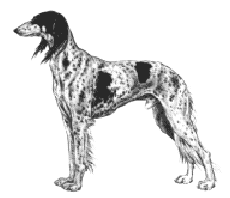Saluki
General Information - Saluki

Group:
Hound
Size:
large
Lifespan:
12-14 years
Exercise:
medium
Grooming:
very low
Trainability:
medium
Watchdog ability:
high
Protection ability:
low
Area of Origin:
Middle East
Date of Origin:
ancient times
Other Names:
Gazelle Hound, Persian
Greyhound
Original Function:
Coursing hare and
gazelles
History
The Saluki is the oldest known breed in the world: its history dates back approximately 9000 years to ancient Syria. From there, the breed spread to Egypt, Persia, India and Afghanistan. Originally a hunter of fox, hare and gazelle, the Saluki was the dog of choice for those in positions of royalty or nobility. The sheiks presented the Salukis as gifts of honour to travelers from abroad and by the year 1100 the breed began to appear in several European countries. As in its country of origin, the breed gained favor and popularity among royalty and several works of art depict the cherished Salukis with their masters. Today the breed is known for its fine companionship.
Temperament
The elegant Saluki makes a distinguished companion, is fond of children, is loyal, affectionate and, because of its keen sense of hearing, makes a good watchdog.
Upkeep
Daily exercise is essential, preferably in the form of free running in a safe, enclosed area. The Saluki’s exercise needs can also be met with long leash walks or jogging. Salukis should sleep inside in all but the warmest climates; they do best as indoor dogs with access to a yard. They can play in snow and cold weather but should not be expected to spend extended time in the cold. The Saluki must have a soft bed, or it could develop calluses. A Saluki in proper weight is naturally thin; however, this breed tends to be a picky eater, which can result in a very thin-looking dog. Many people not familiar with the Saluki wrongly assume that the dog is not being fed properly! The smooth coat needs only occasional brushing to remove dead hair, but the feathered coat needs combing once or twice a week to prevent matting.
Saluki
A breed standard is the guideline which describes the ideal characteristics, temperament, and appearance of a breed and ensures that the breed is fit for function with soundness essential. Breeders and judges should at all times be careful to avoid obvious conditions and exaggerations, as well as being mindful of features which could be detrimental in any way to the health, welfare or soundness of this breed.
Breed Standard - Saluki
 General Appearance:
General Appearance: The whole appearance of this breed should give an impression of grace and symmetry and of great speed and endurance coupled with strength and activity to enable it to kill gazelle or other quarry over deep sand or rocky mountain. The expression should be dignified and gentle with deep, faithful, far:seeing eyes.
Head and Skull: Head long and narrow; skull moderately wide between ears, not domed, the stop not pronounced, the whole showing great quality. Nose black or liver.
Eyes: Dark to hazel and bright, large and oval, but not prominent.
Ears: Long and mobile, covered with long silky hair; hanging close to the skull.
Mouth: Teeth strong and level.
Neck: Long, supple and well-muscled.
Forequarters: Shoulders sloping and set well back, well:muscled without being coarse. The chest deep and moderately narrow. The forelegs straight and long from the elbow to the knee.
Body: Back fairly broad, muscles slightly arched over the loin.
Hindquarters: Strong, hip bones set wide apart, and stifle moderately bent, hocks low to the ground, showing galloping and jumping power.
Feet: Of moderate length, toes long, and well-arched, not splayed out, but at the same time not cat-footed; the whole being strong and supple and well feathered between the toes.
Tail: Long, set on low and carried naturally in a curve, well:feathered on the underside with long silky hair, not bushy.
Coat: Smooth and of a soft, silky texture; slight feather on the legs; feather at the back of the thighs; sometimes with slight woolly feather on thigh and shoulders. (In the Smooth variety the points should be the same with the exception of the coat which has no feathering).
Colour: White, cream, fawn, golden, red, grizzle and tan, tricolour (white, black and tan), and black and tan, or variations of these colours.
Weight and Size: Height should average 58 to 71 cm (23 to 28 in), bitches proportionately smaller.
Note: Male animals should have two apparently normal testicles fully descended into the scrotum.
DNZ No 484
Copyright Dogs New Zealand
01 Jan 2002
Any departure from the foregoing points should be considered a fault and the seriousness with which the fault should be regarded should be in exact proportion to its degree and its effect upon the health and welfare of the dog and on the dog’s ability to perform its traditional work.




